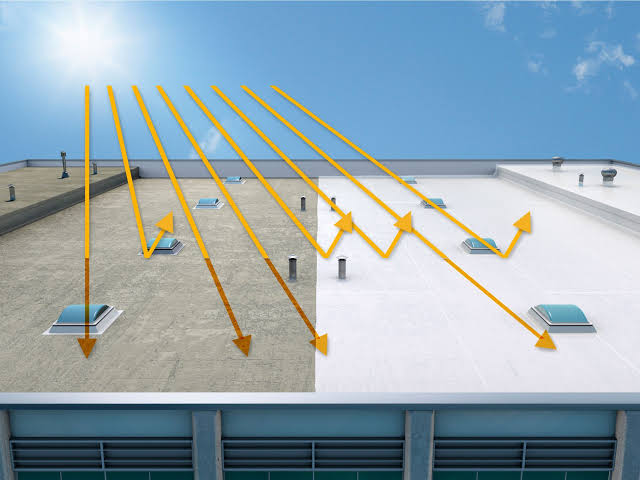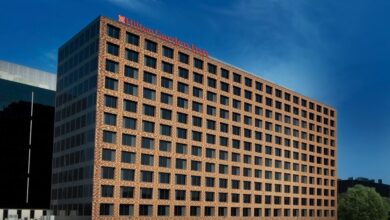As the world continues to grow and expand, we are seeing a steady increase in global energy consumption. This increase has led to a decline in natural resources and an increase in energy costs. In addition, areas with hot climates often suffer the most due to high energy consumption in order to stay cool. The solution to this problem is cool roofs. Let’s explore the benefits of cool roofs and how they can help save energy and money in hot climates.
Overview Of What Are Cool Roofs?
Cool roofs are essentially roofing systems that are designed to reflect sunlight and absorb less heat than traditional roofs. They achieve this by using materials with high solar reflectance (ability to reflect sunlight) and thermal emittance (ability to release absorbed heat).
This results in a cooler surface temperature, reducing the amount of heat transferred into the building below. Cool roofs come in various forms such as white roofs, green roofs, and reflective coatings for existing roofs.
Bigger Impact In Hot Climates
While cool roofs can provide energy savings and other benefits in any climate, they are particularly beneficial in areas with hot climates. This is because these regions experience high heat levels and use a significant amount of energy on air conditioning to combat the heat. By using cool roofs, buildings can reduce their energy consumption for cooling by up to 20%, resulting in significant cost savings for both homeowners and businesses.
Environmental Benefits
Apart from the financial benefits, cool roofs also have a positive impact on the environment. By reducing energy consumption, they help to decrease greenhouse gas emissions and combat climate change. Furthermore, cool roofs can also mitigate urban heat islands areas with higher temperatures due to human activities by reflecting sunlight instead of absorbing it. This helps to improve air quality and reduce heat related illnesses in cities.
Long-term Savings
While the initial cost of installing a cool roof may be slightly higher than traditional roofs, the long-term savings in energy costs make it a worthwhile investment. A study by Lawrence Berkeley National Laboratory found that cool roofs can save homeowners an average of 7% on their annual electricity bills. Additionally, cool roofs can also extend the lifespan of a roof by reducing thermal shock and UV damage, resulting in lower maintenance costs over time.
Energy Efficiency
Cool roofs refer to a type of roof that reflects sunlight and heat, rather than absorbing it. By reflecting heat and sunlight, cool roofs help to keep buildings cooler. This reduces the energy consumption required to cool the buildings, thereby reducing energy costs. Cool roofs work by incorporating a variety of materials that are designed to reflect heat and sunlight. These materials include but are not limited to white or light-colored roofing materials, reflective coatings, and sheet coverings.
Improved Comfort:
Hot climates make it uncomfortable to stay indoors without cooling systems, which only add to the energy bill. Cool roofs improve the comfort level inside the building, by maintaining an optimal temperature. As cool roofs reflect back heat, the inside of the building will stay cooler, which improves the comfort level of individuals living or working in the building.
Lower Environmental Impact:
Cool roofs help reduce greenhouse gas emissions, which contribute to global warming. By reducing the energy consumption required to keep a building cool, less electricity is consumed, which in turn reduces the amount of greenhouse gasses produced. Cool roofs can also help reduce the urban heat island effect, which is when urban areas are significantly hotter than surrounding rural areas due to human activity and construction.
Longer Lasting Roofs:
Cool roofs are made with special materials that help to reflect sunlight and heat. These materials also help to protect the roof from damage caused by exposure to the sun. As a result, cool roofs can last much longer and require less maintenance than traditional roofs. Additionally, cool roofs often require fewer repairs, which can lead to additional savings on maintenance and repair costs.
Government Support:
In today’s world, the governments are taking steps towards making the world a better place to live in, by encouraging and providing incentives to organizations and individuals who use cool roofs. Not only are these roofs a great way to save energy, but they also help in reducing environmental deterioration at large scale. The Government has been providing Tax credits, rebates, and incentives for the installation of cool roofs both for commercial and residential buildings.
How cool roofs differ from standard roofing?
Cool roofs are designed with specific materials and coatings that help to reflect sunlight and heat, whereas traditional roofs absorb this energy. This crucial difference in design is what enables cool roofs to provide the various benefits mentioned above, such as reduced energy consumption, lower environmental impact, and longer lasting roofs. Additionally, cool roofs come in a variety of colors and styles, making them suitable for any architectural design.
Future of Cool Roofs:
As climate change continues to be a growing concern, the future of cool roofs looks promising. With increasing global temperatures and greater demand for energy efficiency, more and more buildings are choosing to install cool roofs. Not only do they provide economic benefits, but they also play a crucial role in reducing carbon emissions and mitigating the urban heat island effect.
Moreover, with advancements in technology, cool roofs are becoming even more efficient and cost-effective. As research and development continue to improve the overall performance of cool roofs, it is expected that the use of these sustainable roofing options will only increase in the future.
Tip for hiring a professional roofer:
Many professional roofing companies are working in the USA. But, before hiring a professional roofing company, don’t forget to check a company’s portfolio, certifications, and reviews.




